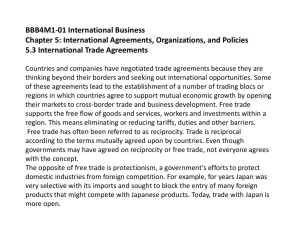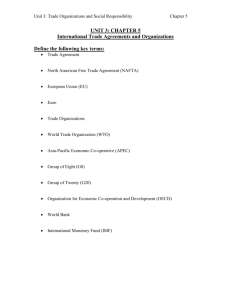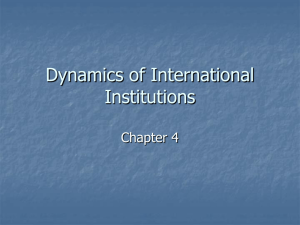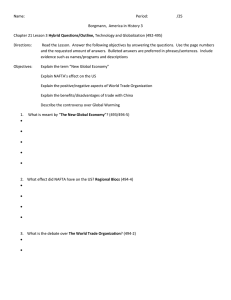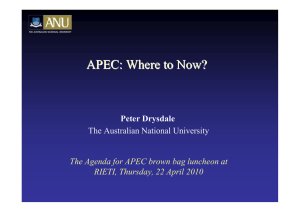Chapter 5: International Agreements, Organizations, and Policies Pg. 157-168
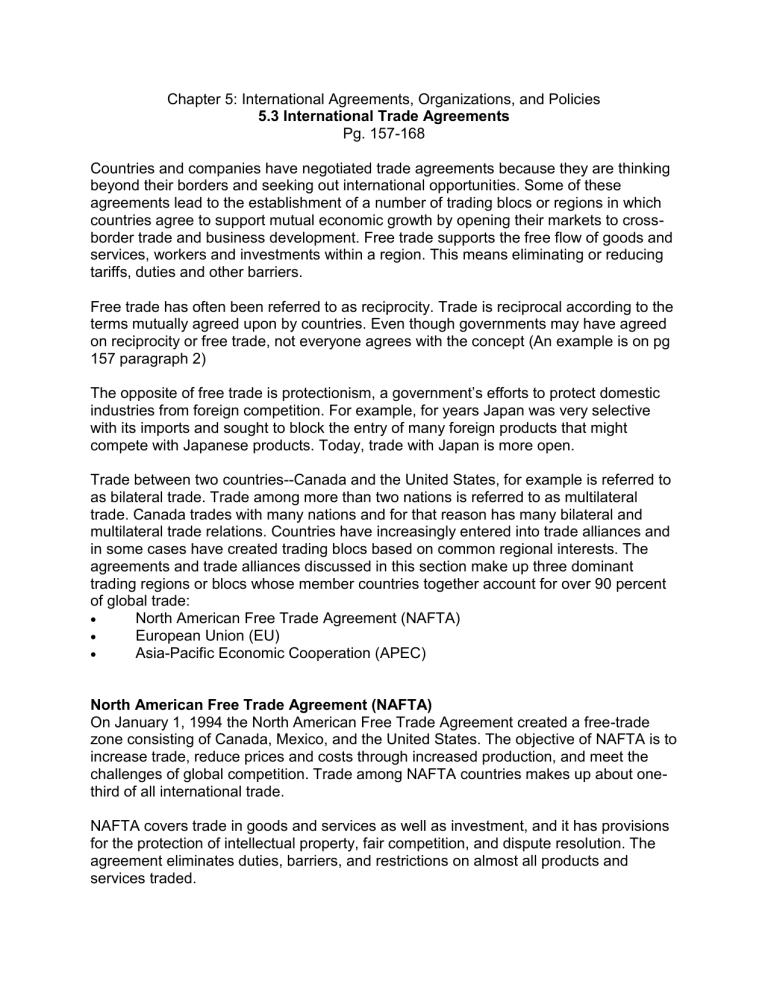
Chapter 5: International Agreements, Organizations, and Policies
5.3 International Trade Agreements
Pg. 157-168
Countries and companies have negotiated trade agreements because they are thinking beyond their borders and seeking out international opportunities. Some of these agreements lead to the establishment of a number of trading blocs or regions in which countries agree to support mutual economic growth by opening their markets to crossborder trade and business development. Free trade supports the free flow of goods and services, workers and investments within a region. This means eliminating or reducing tariffs, duties and other barriers.
Free trade has often been referred to as reciprocity. Trade is reciprocal according to the terms mutually agreed upon by countries. Even though governments may have agreed on reciprocity or free trade, not everyone agrees with the concept (An example is on pg
157 paragraph 2)
The opposite of free trade is protectionism, a government’s efforts to protect domestic industries from foreign competition. For example, for years Japan was very selective with its imports and sought to block the entry of many foreign products that might compete with Japanese products. Today, trade with Japan is more open.
Trade between two countries--Canada and the United States, for example is referred to as bilateral trade. Trade among more than two nations is referred to as multilateral trade. Canada trades with many nations and for that reason has many bilateral and multilateral trade relations. Countries have increasingly entered into trade alliances and in some cases have created trading blocs based on common regional interests. The agreements and trade alliances discussed in this section make up three dominant trading regions or blocs whose member countries together account for over 90 percent of global trade:
North American Free Trade Agreement (NAFTA)
European Union (EU)
Asia-Pacific Economic Cooperation (APEC)
North American Free Trade Agreement (NAFTA)
On January 1, 1994 the North American Free Trade Agreement created a free-trade zone consisting of Canada, Mexico, and the United States. The objective of NAFTA is to increase trade, reduce prices and costs through increased production, and meet the challenges of global competition. Trade among NAFTA countries makes up about onethird of all international trade.
NAFTA covers trade in goods and services as well as investment, and it has provisions for the protection of intellectual property, fair competition, and dispute resolution. The agreement eliminates duties, barriers, and restrictions on almost all products and services traded.
For custom officials to determine whether import tariff charges are applicable a certificate of origin is required with shipments. Products produced outside of NAFTA may incur a duty.
For a product to qualify as a NAFTA product, it must have been at least 50% produced at a manufacturing plant in the region and be composed of materials or components from the region. If a company’s products qualify for NAFTA treatment, then those products will benefit from lower tariff rates.
Free Trade Area of the Americas (FTAA):
Discussions initiated at the 1994 Summit of the Americas in Miami are being pursued with an aim to integrate the economies of the western hemisphere into a single free trade zone, an extension of NAFTA to be known as the Free Trade area of the
Americas. The hope is to reach an agreement by 2005. Finalizing such a treaty will require significant debate and negotiations (as with all treaties and agreements) around issues dealing with the environment, human rights, culture, and labour.
Between 1900 and 2000, Canada, the United States, and our 32 Latin American and
Caribbean partners saw out combined GDP output will grow from $7.1 trillion to $11.4 trillion dollars. The affluent or wealthy nations reaped most of the benefits, however, while the number of people living in poverty grew.
The European Union (EU):
The European Union (EU) is a political and economic alliance in Europe consisting of 15 countries (with 10 candidate countries), formerly known as the European Community.
These nations eliminated trade barriers among the members. The EU represents a new
Europe. One of its most significant economic changes occurred in 1998 when the majority of the EU countries became an economic and monetary union sharing a common currency known as the euro.
The European Union has many advantages for the countries that belong. One is size; its member countries now have access to nearly 380 million consumers. Another advantage is that its manufacturers have uniform standards for technical products in an attempt to ensure greater quality and productivity.
Now the world’s largest single market, the EU has surpassed the United States in both gross dome stic product and population, and ranks as Canada’s second most important trading and investment partner (after the United States).
Economics and technology are bringing down the “fences” (tariffs, protectionism, currency exchange, and government regulatio ns) that use to “surround” countries. For the success of free trade arrangements in a trading bloc such as the EU, citizens of different countries will have to learn to work well with people who may be very different from their own cultural or ethnic group.
The integrated European Union represents one of the world’s largest markets. It has a currency that can compete with the U.S. dollar and the Japanese yen. People and products can move more freely within the region. This flexibility should help EU companies and countries to strengthen their position in the global markets.
Asia-Pacific Economic Cooperation (APEC)
APEC is a forum for ministers and government officials of countries bordering the
Pacific Ocean to discuss regional policy. APEC was formed in 1989. It is not a trade agreement or pact, and has no formal institutional structure. Its long-term purpose is to foster greater economic cooperation in the Pacific Rim in the hope that such cooperation will spill over into the entire international community.
The Pacific Rim includes the circle of earthquake zones and volcanoes that surrounds the Pacific Ocean that is sometimes called a “ring of fire”. Recently it has become to be known as a vast, powerful, and interconnected economic and cultural community that borders on the Pacific Ocean. It includes East Asia, Australia, New Zealand, Papua
New Guinea, and North and South America.
Today APEC has more than 20 participating countries. Because of the inclusion of
China, APEC countries represent ne arly half of the world’s marketplace, on the basis of their population and output. Many APEC countries attract business because they are able to offer “low cost” labour, but the region now offers increasing numbers of highly skilled workers.
APEC countries are very different from each other in terms of size, political system, language, culture, and history. The only thing that connects them is their border on the
Pacific Ocean.
In 1997, several Asian countries in this group had an economic crisis, causing their currencies to devalue overnight. APEC countries still continue to grow and influence the rest of the world.
Several APEC nations have taken the bilateral free trade route. Singapore, Australia, and New Zealand have announced free trade agreements that they hope will eventually become APEC wide. Another Asian regional trade agreement is the Association of
South East Asian Nations (ASEAN). This includes Brunei, Indonesia, Malaysia, the
Philippines, Singapore, Thailand, and Vietnam. It has a total GDP of 1.8 trillion USD.
Efforts are being made to narrow the economic gap between members, especially with regards to the level of digital and information technology.
Canada and the Pacific Rim
Some economists believe Ottawa should move toward an even greater free trade agreement with Japan to reduce Canada’s dependence on the United States. The
Asian Development Bank has forecasted that by 2025, Asia’s share of world GDP will climb to 57% from its 2002 level of 37%.
A recent survey says that Canada is missing out on opportunities to trade and invest in
Asia because it is too focused on the USA. Since Canadian and a\American economies follow similar business cycles, any downturn in American economy would affect Canada
Free Trade or Duty-Free Zones
In 2001 Canadian customs and tax rules encouraged free-trade zones. Foreign companies are allowed to bring goods into Canada and then ship them to the US and elsewhere without paying duty or tax. It is hoped that foreign companies will now be more likely to use Canada s the gateway to the American market.
